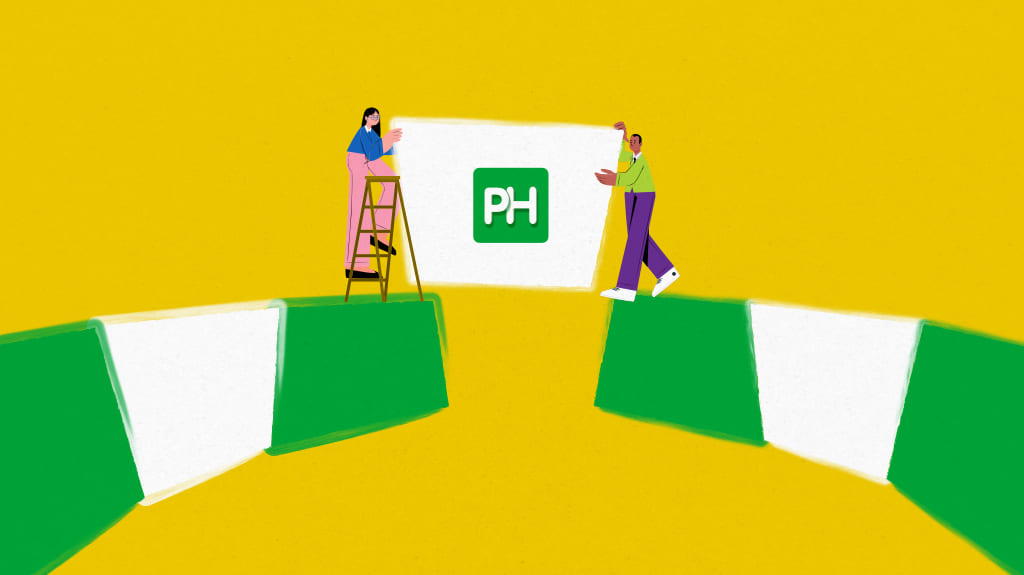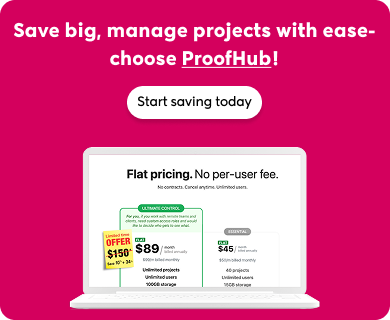Introduction
With over a decade of experience in spearheading the marketing department, I understand the workflow of content development and the importance of effective content collaboration tools.
We’ve all been there, going back and forth with emails to make changes in content and seek approvals.
46% of employees say finding the documents they need is time-consuming and challenging.
Fortunately, today we have powerful content collaboration tools to work faster, organize documents, and collaborate effectively.
In this post, I have listed the top 12 content collaboration tools after a careful review of various key parameters and shared the features to look for while choosing the software for your organization. It will help you end the confusion of ‘which tool to pick’ and make an informed decision.
What is content collaboration software?
Content collaboration software is a tool that helps your team to collaborate on content effectively. It allows you to create, store, share, and edit documents.
A good content collaboration tool brings all the documents to a centralized place and organizes them, facilitates file and document sharing, and allows multiple team members to work simultaneously on the same document.
You can improve your team’s productivity, work together effortlessly, and streamline the content development process with the right tool.
List of top 12 content collaboration tools in 2025
There are many content collaboration tools in the market. Each tool has its strengths and unique features, but essentially, they all focus on making content collaboration easy and effective.
Based on my research, user reviews across the web, and critics’ insights, the following 12 tools emerged at the forefront of the industry:
1. ProofHub – Best for content collaboration

ProofHub is the best content collaboration platform that brings all the essential tools and features together in one place you need for content creation and management.
It’s a breeze to collaborate with ProofHub. Your teams spend less time creating & sharing documents, collaborate on documents in real-time, and make fewer mistakes. No more scattered documents or endless email threads.
ProofHub brings everything together, making your life a whole lot easier. You can easily communicate, share feedback instantly, and have real-time discussions with your team. No more endless email chains or confusion over who said what!
With ProofHub you can collaborate with your team members, clients, and stakeholders in one place and take complete control of the content management.
“The Most Hassle-free Project Management and Team Collaboration platform. – Dharvi S., G2 reviewer
Find out how ProofHub transforms your content collaboration process:
Key features
1. File sharing and version control: No need to waste time searching for files on multiple platforms such as email attachments, Google Drive, and local storage. With ProofHub, you can bring all files to a centralized place so that team members can easily find files without wasting time.
With ProofHub file versioning, you can create multiple versions of a document to avoid confusion and conflicts when multiple team members are working on the same document.
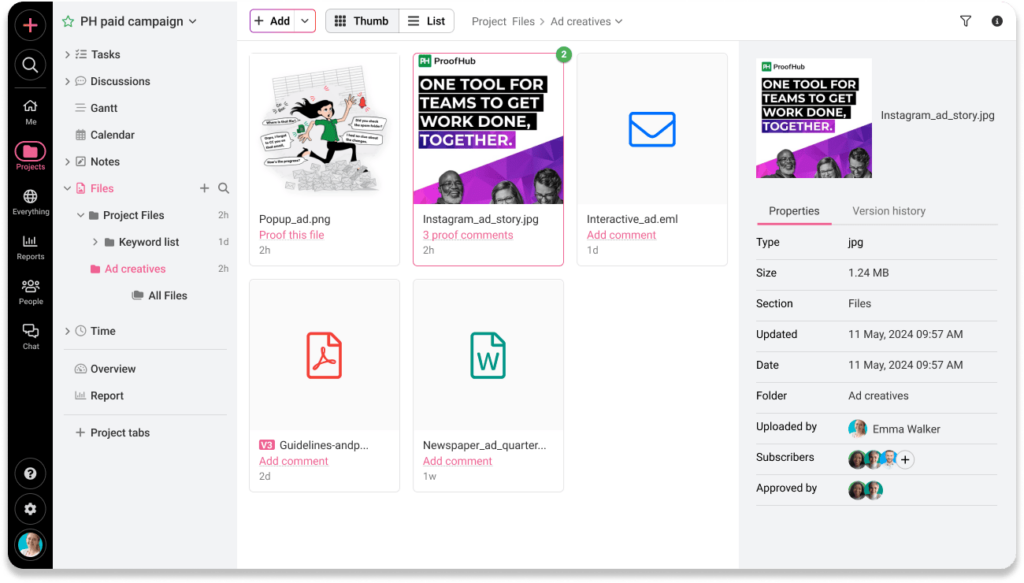
2. Share real-time actionable feedback: No need to conduct a meeting for every small edit. Improves team efficiency and shares feedback instantly from your desk with ProofHub’s powerful online proofing tool. Editors can add annotations to provide clear & actionable feedback on digital creative assets in multiple file formats, including JPEG, PNG, PDF, and more.
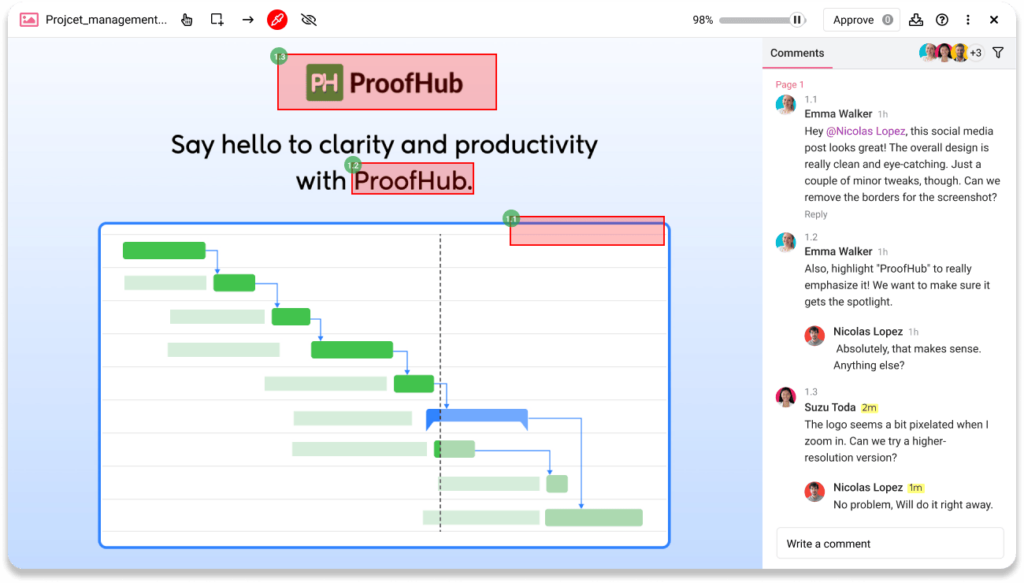
3. Streamline content development with customized workflow: Get rid of misaligned and inconsistent content development processes. Use ProofHub custom workflows to establish standardized content development processes for your teams as per your project requirements. This makes your content development productive, effective, and consistent, and builds a framework for accountability.
4. Simplify content approval process: No last-minute rejections by clients and stakeholders. Successfully delivers projects on time and within budget by inviting external stakeholders to collaborate on creative assets during the development process. Use shareable links to engage stakeholders in the content review and approval process. Use in-built forms to request information and feedback from clients.
5. Centralized team communication: No more communication gaps due to geographical barriers or unproductive communication channels. With ProofHub’s built-in chat, you can instantly connect to any team member one-to-one or in a group to share ideas and make conversations happen in real time. Avoid long email threads and waiting for hours to get replies. You can use ProofHub @mentions to tag team members on tasks to request updates or get special attention.
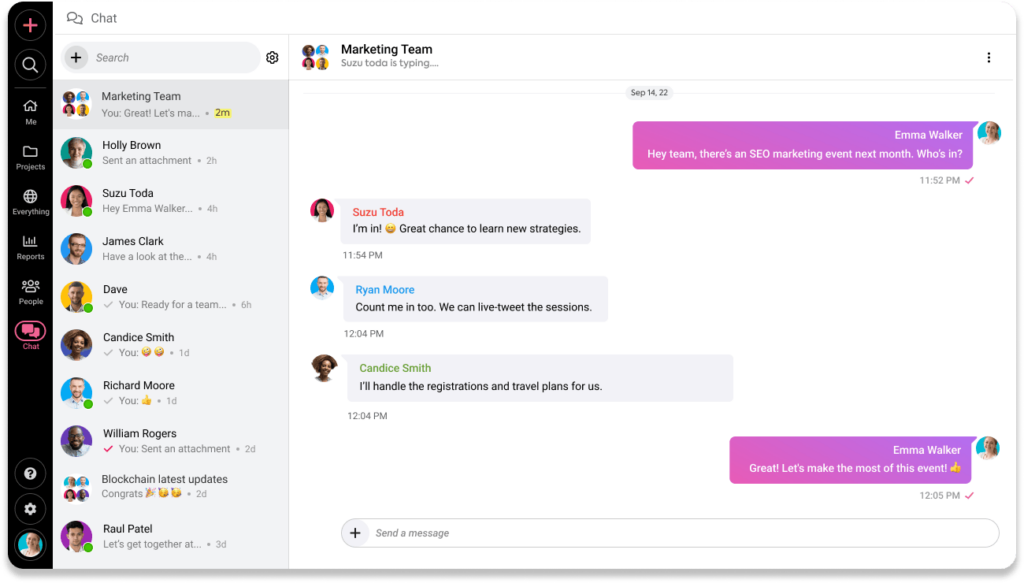
6. Brainstorm content ideas with teams: Break the innovation silos and actively involve all team members to discuss ideas for content development with ProofHub project discussions. It encourages knowledge sharing and helps the team grow. You can also add project stakeholders to discussions and keep everyone on the same page. It also helps you get project requirements documented in one place.
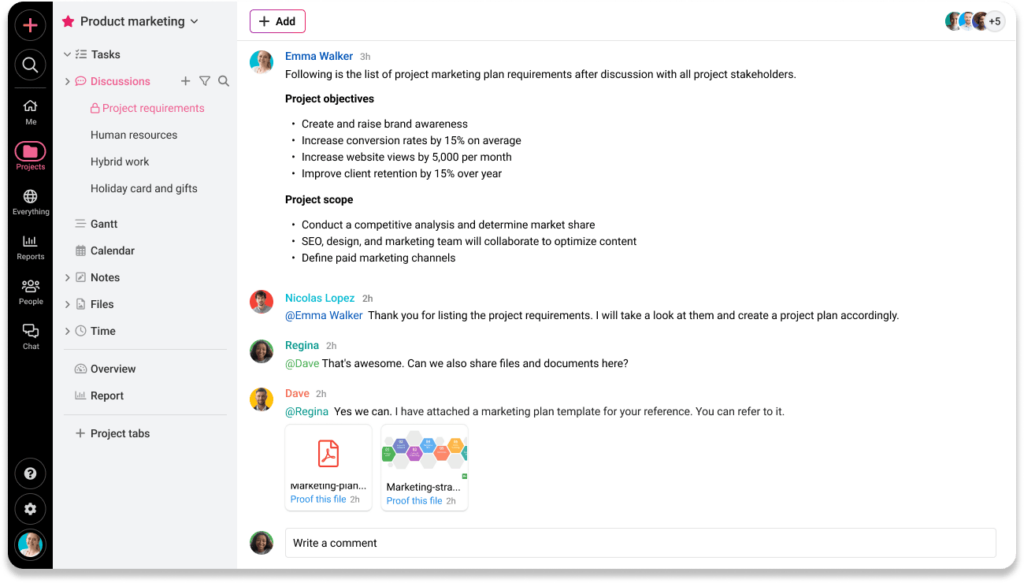
7. Bring transparency to team content collaboration: No more transparency issues and information slipping through the cracks. With ProofHub centralized task management, you can bring all the tasks together in one place and avoid unnecessary back-and-forth communication with teams as you can track the work progress of each task and team member in real time. It helps you to be in better control of content development and deliver content on time.
Apart from this, ProofHub transforms your project management and team collaboration with a range of features, such as multiple project views, project reporting, time tracking, custom roles and permissions, shareable notes, and built-in forms.
Pros
- Replaces multiple content collaboration platforms with one app.
- Intuitive interface and is easy to use.
- Minimum learning curve. Your whole team can adapt it in no time.
- A scalable solution can add as many team members as you want.
- Offers flat pricing, no hidden fees.
- Comes with an in-built chat.
Cons
- Notifications can be overwhelming sometimes.
- Not that suitable for solopreneurs and individual freelancers.
Pricing
ProofHub offers a fixed flat-fee pricing structure, which means there is no per-user fee. For more details, visit the pricing page.
2. Google Drive – Best for content creation
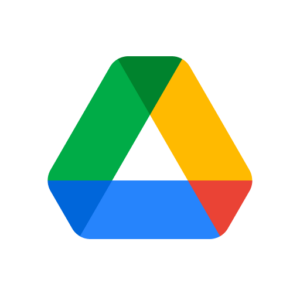
Google Drive is a popular cloud-based content collaboration tool used for content creation, sharing, and co-editing. It helps users to create documents, spreadsheets, slides, forms, and more with Google Drive. It allows multiple users to simultaneously work on the same document in real time. Users can share feedback with real-time comments and track the changes.
Google Drive is a great tool to improve your team’s productivity and make collaboration smarter and easier. It comes under the suit of Google Workspace Apps.
As per my review, it is the most generous and user-friendly cloud-based storage app that integrates with most project management software including ProofHub for effortless collaboration. The only downside is you need to use it with other apps for complete team collaboration.
Key features
- Create documents using Google Docs, Sheets, and Slides.
- Share files with the team using links.
- Custom access and permissions to manage who can view and edit the document.
- Edit documents in real-time and share feedback with in-document comments.
- Version history to track the changes.
Pros
- Easy to use.
- Offline editing.
- Search option to find files in the drive.
- Real-time syncing across devices.
- Integrates with Google Workspace apps and other software.
Cons
- Lack of privacy features.
- No password-protected files.
- Depends on other apps such as Google Chat for complete team collaboration.
Pricing
- Free: Offers 15GB of cloud storage.
- Basic: $1.99 per month, and includes 100GB of storage.
- Standard: $2.99 per month, and includes 200GB of cloud storage.
- Premium: $9.99 per month, and includes 2TB of cloud storage.
3. Bit.ai – Best for workplace collaboration

Bit.ai is a cloud-based workplace collaboration tool that allows you to create, share, and edit content and communicate with teams in real-time. It helps you create live interactive documents and share your content with anyone by sending them a link.
You can collaborate effortlessly with others on any shared document using review comments. It helps you organize all the knowledge in one place.
With its wide range of features and integrations, Bit.ai eliminates the need to switch between multiple tools to create, manage, and share your documents.
Key features
- Create interactive documents using Bit.ai Smart Editor.
- Add various elements to documents such as attachments and live web links.
- Upload your files to the cloud to bring all documents into one place.
- @mentions to help your teams stay coordinated.
- Built-in templates to create marketing proposals, product roadmaps, and more.
Pros
- Content preview of various file types and display visual link preview.
- Create a centralized knowledge base for your company.
- Integrate with other content collaboration apps.
Cons
- Limited formatting and font options for document creation.
- Barbone free plan.
Pricing
Bit.ai offers a free plan and several paid tiers with different features and user limits.
- Free Plan: Up to 5 members.
- Pro Plan: $8 per user/month (Billed annually).
- Business Plan: $15 per user/month (Billed annually).
4. Microsoft OneDrive – Best for cloud storage

Microsoft OneDrive is a cloud-based storage service that helps teams easily collaborate both inside and outside the organization with advanced file-sharing and editing capabilities. It makes it easy for organizations to create, share, store, and edit documents across all devices.
You can create an online backup of files on your PC and phone so that you can access them wherever you are. It comes with real-time data synchronization, version control, access control, and a wide range of document collaboration features.
I found many users prefer Microsoft OneDrive over other cloud-based storage apps due to its seamless integration with the Microsoft Suite of apps.
Key features
- Share and access files from anywhere.
- Get notified of any changes made to the documents.
- Multiple versions to restore documents.
- Custom access and permissions.
- Backup and protect your data files from PC and phone to OneDrive.
Pros
- Free storage.
- Two-stage file deletion.
Cons
- Problems with syncing with other devices.
- Complex user-interface.
- Limited backup functionality.
Pricing
- Free Plan: Offers 5 GB of storage and basic features.
- Microsoft 365 basic plan: $1.99 per month and $19.99 annually and offers 100GB of cloud storage.
- Microsoft 365 Personal plan: Starts at $6.99 per month and $69.99 annually offers 1TB of storage and advanced security features.
- Microsoft 365 Family plan: Starts at $9.99 per month and $99.99 annually and offers 6 TB of storage that is shared among up to 6 people.
5. Dropbox Paper – Best for document organization

Dropbox Paper is another popular content collaboration platform that helps you securely create, store, organize, share, and edit all your files. It is an easy-to-use content collaboration tool for writing documents, making lists, and sharing ideas.
DropBox offers advanced features like folders, file versioning, link sharing, an account transfer tool, and smart sync. It is one of the most popular file storage and information-sharing apps available.
Dropbox Paper is a good fit for remote teams that want to work together in real-time without having to exchange a lot of emails or schedule meetings. Team members can leave comments directly on the content they’re working on instead of sending an email or chat message.
Key features
- Create documents and invite other team members to view or edit them.
- File versioning to track changes.
- Automatically backup important files on your devices.
- e-sign your files to create signed documents.
- Tag teammates and leave comments on specific sections of a document.
Pros
- Easy-to-use interface.
- You can share and store files of large size.
- Transfer large files up to 100GB.
Cons
- Poor storage limit for free users.
- Expensive than other tools.
- Rely on other apps for task management and team communication.
Pricing
- Plus: $9.99 per user per month for 1 user.
- Essentials: $16.58 per month for 1 user.
- Business: $15 per user per month billed annually for 3+ users.
- Business Plus: $24 per user per month billed annually for 3+ users.
6. BoostHQ- Best for knowledge sharing

BoostHQ is a leading knowledge-sharing platform that helps you create a centralized knowledge base for your organization. You can create a centralized resource library for knowledge management that employees need at work in the form of PDFs and videos.
It facilitates content collaboration by offering a range of features to create, edit, and share documents. You can create groups, categories, and tags to share and store documents in an organized way. It makes it easy for your team members to find content.
Key features
- Share and organize content at a centralized place.
- Integrates with Google Docs to help you with content creation.
- Employee discussions to share ideas.
- Robust analytics to provide insights into how your team interacts with content.
- You can build a comprehensive training program.
Pros
- User-friendly interface and beginner-friendly.
- Easy to set up and use.
Cons
- Lack of onboarding support.
- Lack of transparency in pricing.
Pricing
- Lite: Contact for pricing.
- Professional: Contact for pricing.
- Enterprise: Contact for pricing.
7. Bitrix24 – Best for work management

Bitrix24 is an all-in-one work management tool that brings content collaboration, CRM, project management, and automation together. It offers various collaboration features to help your team create, share, and collaborate on content.
You get unlimited file sharing and storage with Bitrix24 Drive. You can also integrate Google Drive, Dropbox, Box, and OneDrive into Bitrix24. This product features automatic cloud backup and “zero-knowledge” encryption to protect your sensitive files and secure file transfer.
I find Bitrix24 a versatile tool, but it can overwhelm the teams who are using it only for content collaboration purposes.
Key features
- Drive to create, share, and edit documents.
- Chat & video calls to communicate with teams in real time.
- Comes with a wide range of third-party integration.
- Workflow automation to save time on repetitive tasks.
- CRM and project management features.
Pros
- Customizable fonts, colors, texts, and more.
- No per-user pricing.
Cons
- Overwhelming features confuse users.
- Come with a learning curve.
- Complex user interface.
- Expensive for small teams.
Pricing
- Free plan: Offers limited features for unlimited users.
- Basic: $49 for up to 5 users per month /year.
- Standard: $99 for up to 50 users per month /year.
- Professional: $199 100 Users Per Month.
- Enterprise: $399 for up to 250 users per month /year.
8. Wrike – Best for team collaboration
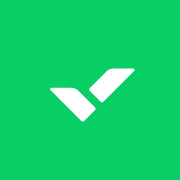
Wrike is a popular team collaboration platform that helps teams transform team communication, and organize all the work in a central place. It provides you with a range of tools to make content collaboration easy and productive.
Your team can attach files to the tasks, collaborate on documents using comments, and tag team members on the tasks for communication. Instead of having files floating around your computer, email inboxes, or cloud storage apps, Wrike consolidates everything into one place.
With the help of Wrike Proofing, you can edit creative assets and share feedback. It is powered by file versioning and rich-markup tools.
Key features
- Store and organize files in a centralized place.
- Real-time team collaboration with @mentions and comments.
- Collaborate on documents and share feedback with online proofing.
- In-built form builder to create interactive forms with conditional logic.
- Integrates with Google Drive, OneDrive, DropBox, Slack, and more.
Pros
- User-friendly interface.
- Templates to create documents.
- Comprehensive team collaboration features.
Cons
- Learning curve.
- Expensive premium plans.
- Does not offer note-taking.
Pricing
Apart from the free plan, Wrike offers four paid plans.
- Team: $9.80/user/month (billed annually)
- Business: $24.80/user/month (billed annually)
- Enterprise: Contact teams for enterprise-level security
- Pinnacle: Custom pricing for advanced features
9. Zoho WorkDrive – Best for large-scale content creation

Zoho WorkDrive is a competent cloud-based content creation and file management platform for teams. It helps you create, store, and collaborate on documents with a powerful suite of Zoho Office Apps such as Zoho Writer, Zoho Sheet, and Zoho Show.
You can upload the files to create online backup and import files from the cloud storage. You can share the feedback in real time with file annotations.
Zoho WorkDrive helps you organize your documents into folders to make it easy to find information.
Key features
- Create documents with Zoho Writer, Zoho Sheet, and Zoho Show.
- Manage file access with custom permissions.
- Smart search to easily find files.
- Templates to create project documentation.
- Share feedback on the documents with file annotation.
Pros
- Sync changes in real time.
- Highly secure platform with industry compliance.
- Comes with powerful integrations.
- Available across devices including phones, tablets, and desktops.
Cons
- Not beginner-friendly UI.
- Not ideal for small teams.
- No option to retrieve files if deleted.
Pricing
Zoho WorkDrive plans start from $1.70 per user per month. There is no free plan.
10. Amazon WorkDocs – Best for enterprise-level document collaboration

Amazon WorkDocs is an enterprise-level secured content collaboration service that helps teams connect everywhere with effortless document creation, sharing, and collaboration.
It integrates with Microsoft Office to help you create and edit documents. You can share feedback with comments and mentions. It provides you with a WorkDocs Drive to bring all the documents in one place.
For organizations looking for a secure Google Drive alternative at the enterprise level, I find Amazon WorkDocs a great, secure platform. It seamlessly integrates with Microsoft Office.
Key features
- Create project documentation with Amazon WorkDocs.
- Share feedback with private comments, format comment text, and @mentions.
- Sync secure files automatically and access them offline or online.
- Migrate all your organization’s data to the cloud.
Pros
- Highly secure platform with AWS global cloud infrastructure.
- Encrypted document transfer to share files securely.
- Integrate WorkDocs with existing applications.
Cons
- Complex user-interface.
- Poor customer support.
- Expensive for small teams.
Pricing
Amazon WorkDocs has a straightforward pricing structure. In most regions, it costs $5 per user per month. Each user receives 1 TB of storage.
11. Confluence– Best for agile teams
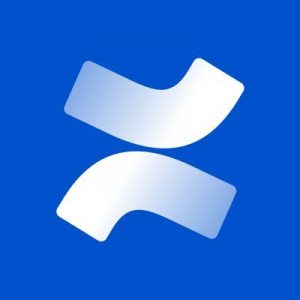
Confluence is another popular content collaboration platform to create, share, store, and co-edit content for teams of all sizes. It helps organize all of your documents and knowledge work in a centralized place.
You can create documents using Confluence pages and share them with the team. Anyone with permission can view and edit the document and share real-time feedback comments and mentions. You can track changes with multiple file versions.
I like its “Home & personalized Feed” feature to share company-wide information. It is among the top free cloud content collaboration software for businesses and makes a great alternative to OneDrive and DropBox to create a remote-friendly workplace.
Key features
- Create, share, and access content with pages from anywhere.
- Store all the knowledge work on cloud storage.
- Collaborate with your team in real time with comments and mentions.
- Customized permissions to manage access.
Pros
- Easy to use and user-friendly.
- Can be used across multiple devices.
- Built-in templates for project documentation.
Cons
- Challenges with integrations.
- Expensive paid plans.
Pricing
- Free: Free for up to 10 users. Access control is not available and there is no business support for free users.
- Standard: $4.89 per user per month.
- Premium: $8.97 per user per month.
- Enterprise: Contact the sales team for pricing.
12. Box – Best for file sharing

Box is a versatile cloud storage and file-sharing platform that provides you with a central place to store and share all your project files and documents. You can create documents and share them with your teams using shareable links.
Box improves teamwork and team productivity by offering you a range of features such as file sharing, custom search filters, and user statistics.
If you are looking for cloud storage services that boost team collaboration and productivity, Box is just the perfect option for you. But, you need to pair it with other apps for task management and effective team communication.
Key features
- Store, share, and access all the files securely on the cloud.
- Edit, review, and summarize your content with Box AI.
- Integrated e-signatures with Box Sign.
- Whiteboarding to collaborate with teams.
Pros
- Unlimited storage.
- Integrate with over 1500 software apps.
- Strict data privacy.
Cons
- File upload/download up to 5 GB.
- Limited features in the free plan.
Pricing
Box paid plans start from $14/month.
What features should you look for in content collaboration software?
There are many content collaboration solutions and software in the market. Good content collaboration software makes it easy and efficient for your teams to collaborate on content.
I have taken into account features, such as the ability to easily upload & share documents, co-edit documents, create file versions, & share feedback, and instantly communicate with the team, while creating the above list.
Here are the top features you should look for in the software:

- File sharing: The software should provide you with an easy-to-use platform to share files securely with your teams so that team members can easily find files from anywhere and work faster.
- Centralized platform for document storage: There should be a centralized place for your team to organize and store documents in folders, categories, or groups so that everyone on the team can find documents quickly.
- Online proofing: A good content collaboration tool allows your team to collaborate in real-time so that your teams can work efficiently. Look for features like task comments, file annotations, file versioning, and @mentions to make online proofing efficient.
- Custom permissions: You should be able to control access and manage permissions so that you can decide who can view, edit, and comment on the documents.
- Custom workflows: The software you choose must provide the capability to create custom workflows so that you can establish standardized processes for consistent, efficient, and productive content creation.
- Centralized task management: Find a tool that helps you manage all the tasks from a centralized place and track progress in real-time so that you know who is working on what and better control your projects.
- Availability across devices: You should be able to access your content collaboration tool across devices such as mobile, laptop, and tablet. It makes it easy to collaborate with a team from anywhere.
Why is content collaboration important for content teams?
Content collaboration makes the content development process innovative, productive, and efficient for teams. Here are the five key benefits of content collaboration for your content teams:
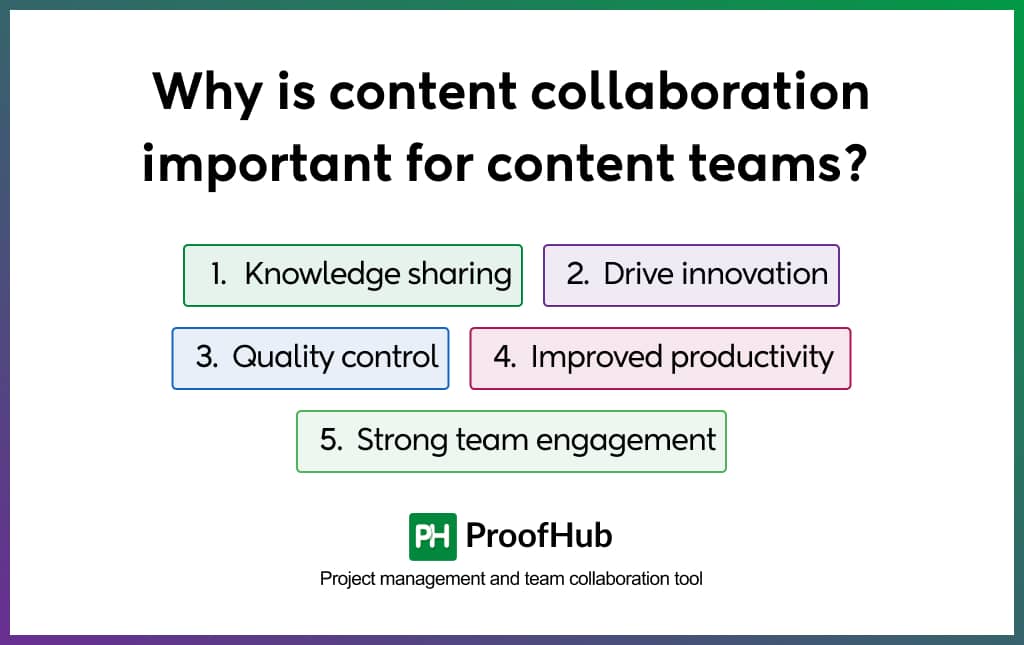
- Knowledge sharing: Make it easy for your team members to share knowledge, discuss ideas, develop skills, and work together. It helps everyone grow.
- Drive Innovation: When team members from different backgrounds, perspectives, and expertise come together, it drives innovation in content development. It helps you create quality products.
- Quality control: When everyone is working together, it helps improve quality by detecting errors at early stages and sharing instant feedback. It helps you produce high-quality content.
- Improved productivity and efficiency: Content collaboration enables team members to work together simultaneously as per the set workflow in real-time. It improves productivity and eliminates the need for time-consuming back-and-forth communication.
- Strong team engagement: When you are working in a team and interacting with each other regularly, it makes work fun and boosts team engagement. It increases the sense of belonging.
Transform content collaboration at your organization with ProofHub
Knowledge sharing and collaboration are at the heart of effective content collaboration. Without an organized and collaborative content creation process, your organization’s content development is scattered and misaligned. ProofHub helps you bring knowledge sharing and team collaboration together all in one place.
ProofHub is your ultimate solution for content collaboration. It brings all your content together, keeps everything organized, streamlines the feedback process, ensures efficient task management, and facilitates seamless collaboration with teams.
FAQs
What is a content collaboration?
Content collaboration is when multiple people work together to create content. It includes creating, sharing, and editing files, multiple members working on the same document simultaneously and sharing feedback.
How do you collaborate on content?
You can collaborate on content using a content collaboration tool. It helps you create, share, store, and co-edit documents. You can also communicate in real-time and share knowledge.
How to choose the best collaboration tools for your business?
The choice of tool depends on your business needs. One organization may prefer one feature over another. One may be interested in document management or advanced content creation capabilities.
What digital tool is the best for collaboration?
It is hard to pick the best digital tool for content collaboration. However, the top content collaboration software includes ProofHub, Google Drive, and Confluence.
Related articles-
